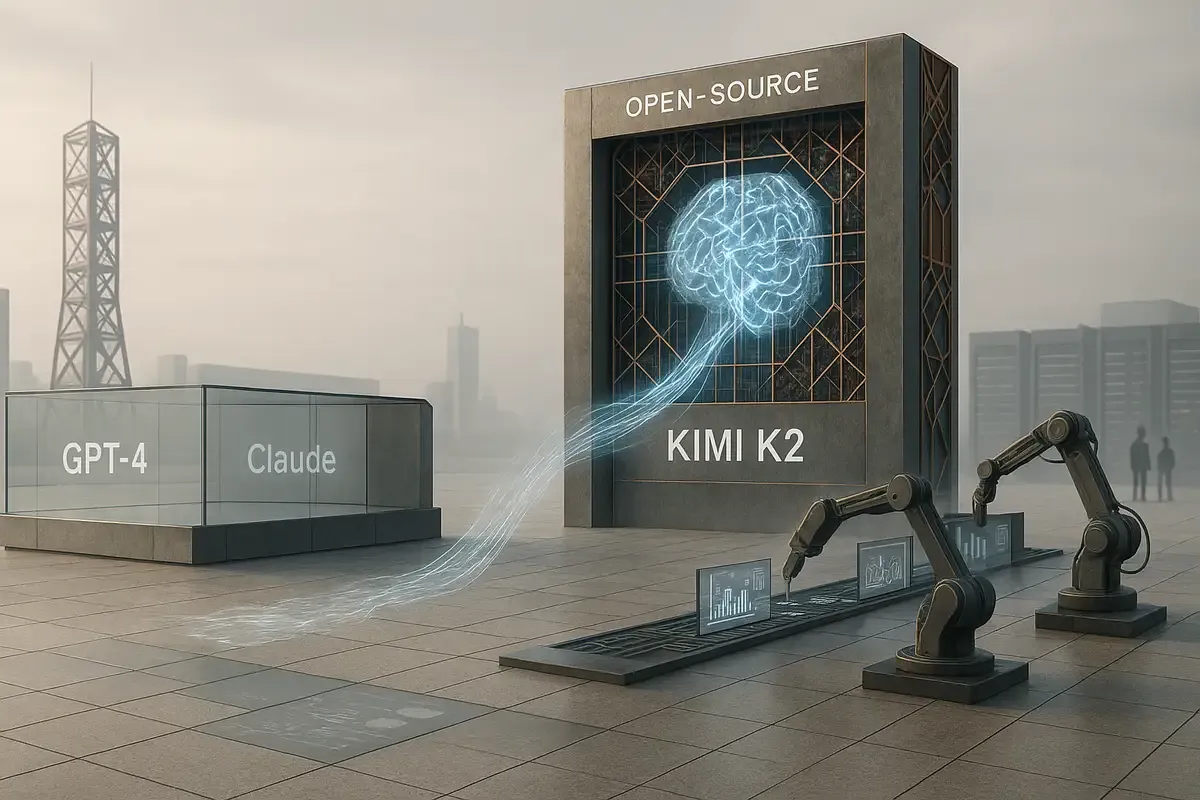💡 TL;DR - The 30 Seconds Version
👉 Moonshot AI released Kimi K2, an open-source model with 1 trillion parameters that matches GPT-4.1 on coding benchmarks while costing five times less.
📊 Kimi K2 scored 53.7% on LiveCodeBench versus GPT-4.1's 44.7% and achieved 97.4% on MATH-500 compared to GPT-4.1's 92.4%.
💰 API pricing sits at $0.60 per million input tokens versus Claude Sonnet 4's $3, creating a pricing trap for Silicon Valley incumbents.
🔧 The breakthrough MuonClip optimizer enabled stable training of trillion-parameter models with zero instability, potentially cutting AI training costs.
🌍 China's open-source strategy now produces models matching closed US systems, forcing competitors to rethink both pricing and business models.
🚀 Unlike chatbots that just talk, Kimi K2 executes complex workflows autonomously, marking the shift from conversation to action in AI.
Moonshot AI dropped a model that Silicon Valley didn't see coming. The Chinese startup's Kimi K2 matches or beats GPT-4.1 and Claude Sonnet 4 on key benchmarks while costing a fraction of what competitors charge. More importantly, it's completely open-source.
The timing stings. OpenAI announced they would delay their planned open-source model just hours after Kimi K2's release. Coincidence? Probably not.
Kimi K2 packs 1 trillion total parameters but only activates 32 billion per token through a mixture-of-experts architecture. This design makes it computationally efficient while maintaining the power needed for complex tasks. The model comes in two versions: K2-Base for researchers who want full control, and K2-Instruct for immediate use in chat and autonomous agent applications.
The Numbers Tell a Different Story
Benchmarks usually bore people. These don't. Kimi K2 scored 53.7% on LiveCodeBench, crushing GPT-4.1's 44.7% and DeepSeek-V3's 46.9%. On MATH-500, it hit 97.4% compared to GPT-4.1's 92.4%. The model achieved 65.8% on SWE-bench Verified, a brutal software engineering test that measures whether AI can spot and fix real code bugs.
But here's the kicker: Moonshot's API costs $0.60 per million input tokens and $2.50 for output. Claude Sonnet 4 charges $3 for input and $15 for output. Kimi K2 delivers comparable performance for roughly five times less money.
The cost advantage creates a nasty problem for incumbents. Match Moonshot's pricing and compress margins on their most profitable products. Don't match it and watch customers flee to a model that works just as well for less.
Beyond Benchmarks: AI That Actually Does Things
Most AI models excel at conversation but struggle with execution. Kimi K2 flips this dynamic. The model was trained specifically for "agentic" workflows—breaking down complex tasks, using tools, writing code, and delivering results without constant human guidance.
Demonstrations show the model autonomously analyzing salary data through 16 Python operations, generating statistical visualizations, and building interactive web pages. Another example involved planning a London concert trip through 17 tool calls across search engines, calendars, email, flights, accommodations, and restaurant bookings.
This represents a shift from thinking to acting. While competitors focus on making AI sound more human, Moonshot prioritized making it more useful.
The MuonClip Breakthrough Changes Everything
Buried in Moonshot's technical documentation sits a detail that could reshape AI economics. The company developed MuonClip, an optimizer that enabled stable training of a trillion-parameter model with "zero training instability."
Training instability has been the hidden tax on large language model development. Companies restart expensive training runs, implement costly safety measures, and accept suboptimal performance to avoid crashes. Moonshot's solution addresses exploding attention logits by rescaling weight matrices in query and key projections—fixing the problem at its source.
If MuonClip proves generalizable, it could dramatically reduce the computational overhead of training large models. In an industry where training costs run tens of millions of dollars, even modest efficiency gains translate to competitive advantages measured in quarters, not years.
China's Open-Source Strategy Gains Momentum
Kimi K2's release reflects a broader trend among Chinese AI companies toward open-source development. This approach builds developer communities, expands global influence, and serves as a countermeasure to U.S. technology restrictions.
Moonshot needed this win. The company's Kimi application ranked third in monthly active users last August but dropped to seventh by June 2025. DeepSeek's disruptive release of low-cost models intensified the domestic AI price war, forcing Moonshot to respond.
By open-sourcing their flagship model, Moonshot adopts a strategy that leverages the global developer community to accelerate innovation while building competitive moats nearly impossible for closed-source competitors to replicate.
Hardware Requirements Remain Steep
Running Kimi K2 locally requires serious hardware. The full model demands multiple high-end GPUs or a robust cluster setup. A 4-bit quantized version can run on two Apple M3 Ultra machines with 512 GB RAM each, according to MLX developer Awni Hannun.
Most users will access the model through Moonshot's API or try it free on the company's website. Hugging Face also hosts demos, though performance may lag on shared infrastructure.
The model operates under a Modified MIT License with one requirement: products with over 100 million monthly active users or more than $20 million in monthly revenue must display "Kimi K2" prominently in their user interface.
Silicon Valley Scrambles to Respond
The implications extend beyond impressive benchmark scores. Enterprise customers have waited for AI systems that complete complex workflows autonomously, not just generate demos. Kimi K2's strength on real-world coding tasks suggests it might finally deliver on that promise.
Western AI labs have largely converged on variations of the AdamW optimizer. Moonshot's bet on Muon variants suggests they're exploring different mathematical approaches to optimization. Sometimes the most important innovations come from questioning foundational assumptions rather than scaling existing techniques.
The open-source component isn't charity—it's customer acquisition. Every developer who downloads Kimi K2 becomes a potential enterprise customer. Every community improvement reduces Moonshot's development costs.
Why this matters:
• China's open-source AI strategy now produces models that match closed U.S. systems at a fraction of the cost, forcing Silicon Valley to rethink both pricing and business models.
• The breakthrough isn't just about benchmarks—it's about AI that finally executes complex tasks instead of just talking about them, marking the transition from conversation to action.
❓ Frequently Asked Questions
Q: How can I try Kimi K2 right now?
A: Visit kimi.com and switch to the K2 model in the dropdown (requires login). You can also find demos on Hugging Face Spaces. For API access, Moonshot charges $0.60 per million input tokens and $2.50 for output tokens.
Q: What does "mixture-of-experts" mean in simple terms?
A: Instead of using all 1 trillion parameters at once, Kimi K2 activates only 32 billion specialized "experts" for each task. This makes it much faster and cheaper to run while maintaining the power of a massive model.
Q: Can I run Kimi K2 on my home computer?
A: Not easily. The full model requires multiple high-end GPUs. A compressed 4-bit version can run on two Apple M3 Ultra machines with 512 GB RAM each. Most people should use the API or web interface instead.
Q: What does "agentic" mean?
A: Agentic AI acts instead of just chatting. Kimi K2 can write code, use tools, search the web, and complete multi-step tasks without constant human guidance. Think assistant that actually does work versus one that just gives advice.
Q: Who is Moonshot AI?
A: A Chinese startup founded in 2023 by Tsinghua University graduate Yang Zhilin. Backed by Alibaba, the company gained fame with their Kimi chatbot but lost ground to DeepSeek. Their app dropped from 3rd to 7th place in China between August 2024 and June 2025.
Q: Is Kimi K2 really free and open-source?
A: Yes, with one catch. If your product has over 100 million monthly users or $20 million monthly revenue, you must display "Kimi K2" prominently in your interface. For most users and companies, it's completely free to use and modify.
Q: How does this compare to DeepSeek's models?
A: Kimi K2 outperforms DeepSeek V3 on key coding benchmarks (53.7% vs 46.9% on LiveCodeBench). Both are Chinese open-source models, but Kimi K2 focuses more on tool use and autonomous task execution rather than pure reasoning.
Q: Is this actually better than ChatGPT for regular users?
A: For coding and complex tasks, yes. Kimi K2 beats GPT-4.1 on programming benchmarks (53.7% vs 44.7%) and costs much less. For casual conversation, ChatGPT might feel more polished. Kimi K2 excels when you need actual work done.








